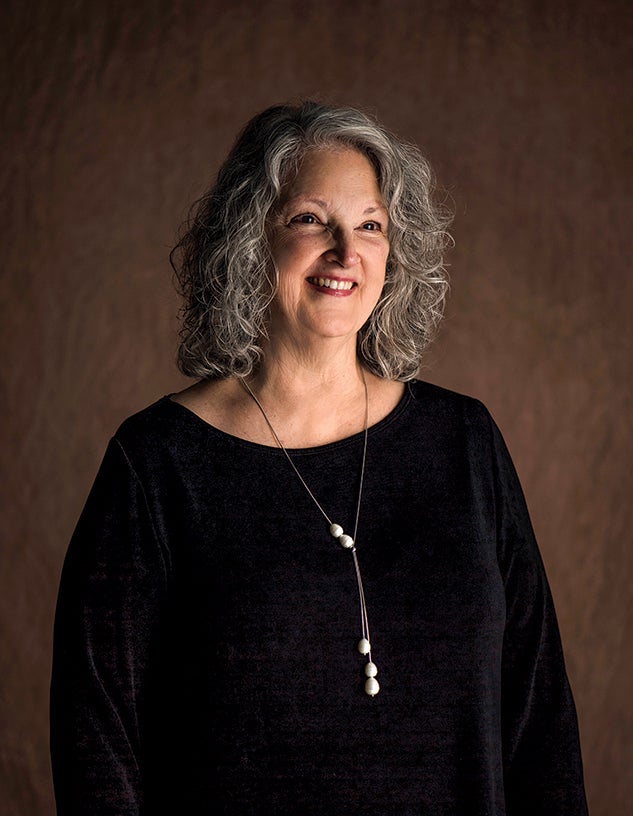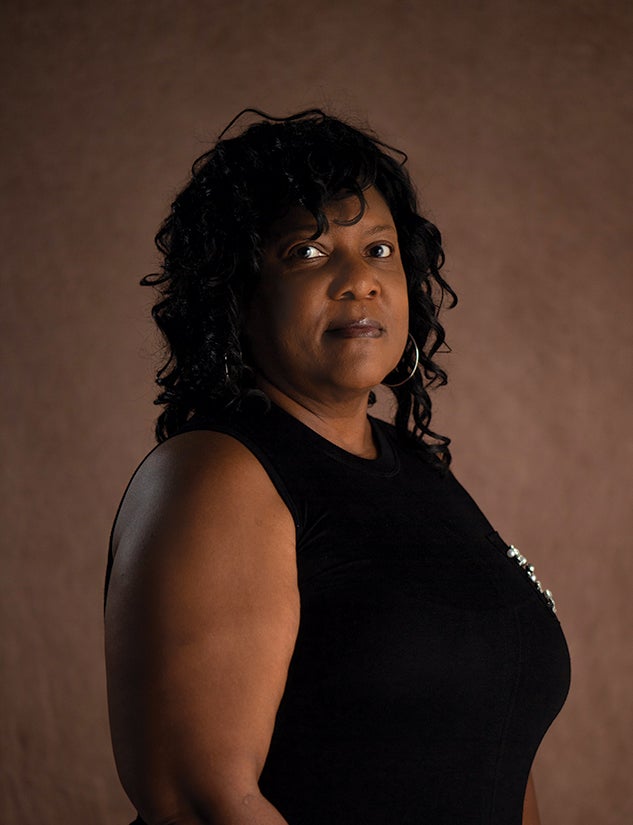When Words Fail
Aphasia researchers examine the nature of language.

For Susan Hoffius, an English as a second language teacher at the Glasscock School of Continuing Studies, her stroke started as an intense migraine. After scrambling to find a replacement substitute for her class, she spent the day in bed, her anxious husband checking on her at periodic intervals. Within a day, she had passed out due to a massive brain hemorrhage that was 10 centimeters in diameter, or roughly the size of an orange.
Hoffius spent the next three months in the hospital. A few months into her recovery, while staring at a friend’s phone, she realized she couldn’t recognize the words printed on the screen. “I was terrified,” she said. “I couldn’t read a letter.”
Gaylen Poole, a health care auditor, first noticed the symptoms of her stroke at church, when a young boy pointed out drool on her cheek. A worried friend took her to the hospital, where a nurse said the words, “stroke victim.” Hearing the nurse, Poole looked around, wondering who that was, only to realize she was the patient. When she woke up, she found herself unable to speak a single word. Poole experienced a bewildering mixture of recognizing the medical terminology spoken by the doctors while also struggling to recall simple words such as “chair.”
“It was scary,” she said. “I was confused, like a little baby.”
For most of us, language is something we take for granted. We listen to the words of a friend, understand the words they are saying and reply in kind. We glance at written words on a page, our brain organizing these words into sentences and paragraphs, turning them into a story that makes sense. All of this requires a complex relay of visual and auditory cues, as well as the ability to integrate these cues into meaning.
Both Hoffius and Poole had a long, hard road ahead of them, one that would test their endurance and resolve. They both developed aphasia, which is the impairment of language following brain damage, as a result of their stroke. During their recovery, they had to relearn how to read, write and speak.
Hoffius, who spent 26 years teaching English, describes her recovery as similar to the process her foreign language students went through, learning the alphabet and how to read all over again. “I have a new understanding of my students,” she said.
During their recovery, both Poole and Hoffius found their way to Rice’s T.L.L. Temple Foundation Neuroplasticity Laboratory. There, they work with Rice researchers including Simon Fischer-Baum, an assistant professor of psychological sciences, and Randi Martin, the Elma Schneider Professor of Psychological Sciences, to help establish a better understanding of the kinds of language problems suffered by people with aphasia.
The Many Different Forms of Aphasia
The brain is made up of billions of neurons and glia, all connected in a network of staggering complexity. Contained within the brain, in a set of networks we don’t fully understand yet, is the ability for language.
For most of us, language is something we take for granted. We listen to the words of a friend, understand the words they are saying and reply in kind. We glance at written words on a page, our brain organizing these words into sentences and paragraphs, turning them into a story that makes sense. All of this requires a complex relay of visual and auditory cues, as well as the ability to integrate these cues into meaning.
What we think of as language — the written and spoken word — is in fact a hugely complex process, one that incorporates many different parts of the brain. When parts of the brain sustain damage, such as during a stroke, the results are every bit as complicated and nuanced as language itself.
During a stroke, the blood supply to the brain gets cut off. Deprived of oxygen, cells begin to die. Depending on the severity, a stroke patient can be left with impairments ranging from mild to severe, affecting everything from memory to the ability to walk and talk.

One possible result from a stroke is aphasia, a condition that affects each patient differently. Some aphasia patients can understand what people say but struggle with speaking. Some can speak but have difficulty reading or writing. Others struggle with hearing words but can hear sounds such as the barking of a dog or the jangling of keys. Some people can write but lose their ability to read. Others can read words but struggle to put them into sentences.
“Language difficulties come in many different forms, nearly as many forms as the number of people who come into our lab,” said Fischer-Baum. These different forms of aphasia are a testament to the many steps involved in understanding and expressing language, whether written or verbal.
Following Stroke Patients During Recovery
Martin and Fischer-Baum’s research groups are examining complementary aspects of aphasia and the recovery process. For one part of their work, Martin’s group recruits patients within a few days of their stroke, following them over the course of a year, performing MRI imaging and cognitive testing. This work, which is done in collaboration with Baylor College of Medicine faculty member Tatiana Schnur, helps establish the initial symptoms as well as get a sense for how the healing process is associated with early improvements.
“At each time point, we’ll relate the damage to whatever kind of difficulties they’re having,” Martin said.
Although the first year following a stroke is when patients make the most dramatic improvements, recovery is a lifelong process — one that is a testament to the brain’s resiliency.
Both Martin and Fischer-Baum’s research groups examine patients later in their recovery when the brain has healed. At this point, the brain is adapting to its new limitations, finding ways to compensate for lost abilities. Depending on the patient, this work can go on for months or years. “We have patients who have been coming in every week for years,” Fischer-Baum said.
Neuroplasticity is the ability of the brain to form and reorganize synaptic connections. Every time you learn something, the brain rewires itself just a little bit, pruning and refining the connections between neurons. Following a brain injury such as stroke, the brain can adapt these connections to compensate for whatever is lost.
Developing long-term relationships with patients offers an opportunity to look at specific aphasia cases in depth, as well as track their recovery over time. Plus, as Fischer-Baum points out, patients become part of the family after a while. “We like them, and this is a good environment for them.”
With this research, the benefit goes both ways. Patients gain a deeper knowledge about their specific form of aphasia, while the research groups working with patients gain valuable insights that will help others in the future.
Neuroplasticity: The Ability of the Brain to Reorganize Itself
Neuroplasticity is the ability of the brain to form and reorganize synaptic connections. Every time you learn something, the brain rewires itself just a little bit, pruning and refining the connections between neurons. Following a brain injury such as stroke, the brain can adapt these connections to compensate for whatever is lost. Generally speaking, after a stroke, brain activity will increase in either the area around the injured region or in a complementary area, such as switching from one side of the brain to the other. This is one of the reasons why, years after a stroke, patients can still improve.
The tests performed by Fischer-Baum and Martin’s research groups are aimed at defining the exact limitations of a stroke patient’s language ability, while also looking at how the brain has changed, both as a result of the initial injury and how the brain has adapted.
The results are sometimes surprising, offering new insights about how our brain receives and processes language, as well as its capacity for reorganizing.
“What you really want to find are the striking contrasts,” Fischer-Baum said. Examples of striking contrasts include losing the ability to hear language but not other types of sounds, or losing the ability to see letters but not other types of shapes, or losing the ability to remember the sounds of words but not the meaning of words.
If there is a sudden difference in a patient’s performance between two similar tasks, it offers more information about the exact nature of a patient’s impairment and how the brain processes language.
“We can analyze the patterns of errors to address broader questions about the nature of mental cognition,” Fischer-Baum said. Long term, understanding the different variations in aphasia as well as the brain’s capacity for healing and reorganizing promises to help improve treatment options, both by refining existing therapies and suggesting new ones.
The Road to Improvement
For patients like Hoffius and Poole, recovery is an ongoing process. These improvements don’t come easy. For every story of a patient making a miraculous recovery, there are other stories of patients who struggle to make minimal gains. Sometimes these contrasts can be heartbreakingly frustrating, with two very similar patients having two very different recovery outcomes.
“Don’t compare one stroke to another. There is no comparison,” Poole said. “Everybody’s stroke is different.”
Poole described sitting in a stroke recovery support group for months, afraid to speak. “I was in this classroom with other people like me,” Poole said. “Wanted to say something, but scared.”
After a while, with the support of people who were going through the same struggles, Poole started to open up. She started to speak again. With practice came improvement.
Both Poole and Hoffius have made good use of the available resources, such as attending support groups at the Houston Aphasia Recovery Center. “Improvements often come from targeted, fixed practice,” said Lynn Maher, a University of Houston faculty member and one of the founders of the Houston Aphasia Recovery Center, which offers programs for aphasia patients as well as their families and caregivers. “This takes a lot of time and effort.”
For Hoffius and Poole, the continued capability for improvement has been a lifeline. When Hoffius first got home from the hospital, she spent months staring at a poster in her living room until she could finally recognize the printed letters L-O-V-E. By the end of the first year, she could read at a third grade level, with her first book being Houston-area author Randy Cecil’s book, “Lucy,” about a tiny dog, a nervous girl and a juggler. Almost three years into her recovery, she still struggles with reading and numbers. Although Hoffius will likely never work again, she is adjusting to her new life — to her new normal. “It’s still there, but it’s not normal,” Hoffius said. “It’s my normal.”
For Poole, should you pass her on the street, you would never guess that just a few years ago, doctors told her she would never be able to walk or talk again. Talking is more difficult because it takes a lot of energy, similar to a grueling workout, while many of the words exist just at the tip of her tongue — there in her mind but frustratingly out of reach.
Both Hoffius and Poole possess a ferocious work ethic and a determination to recover as much as they can. Along the way, as they continue to improve, their collaboration with Fischer-Baum and Martin means they’re also helping other aphasia patients.
“Little by little, better, better, better,” Poole said.
